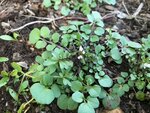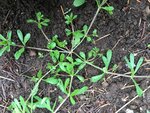

A rose by any other name might smell as sweet, but a weed by another name is a different story. A weed known by its scientific Latin name can be transformed in our minds from a pest to a gift of nature.
That’s because if you learn the Latin name, you’ve probably learned about the weed’s creative ways of growing and multiplying in your garden. The more you know about a weed, the harder it is to bear it any grudge. Even if you don’t quite learn to love them, at the very least you come to respect them as worthy opponents, most of whom you will never completely vanquish.
Every uncultivated, unwelcome plant in our gardens has a life story worth knowing. Here are two of them:
Bedstraw is also known as stickwilly, cleavers, catchweed, grip grass and several other names. Its formal name is Galium aparine.
It’s a rather delicate-looking, vining plant that can grow six to ten feet long. It will climb any plant or fence that’s handy or sprawl along the ground. It has a very thin root, which usually breaks off at ground level when you try to pull it by hand, so it’s guaranteed to regrow. That’s one way it survives. It also hides under shrubs and perennials, so it’s often not seen until it’s already grown up and gone to seed.
But foiling gardeners trying to weed it out is bedstraw’s Plan B.
It’s Plan A is to stick to everything and everyone who touches it. Its seeds are sticky, too; they will stick to shoes, pantlegs, and animal fur and turn you, your dog, and your cat into unwitting seed dispersal agents.
It also makes the world a better place:
Shotweed, also known as spitweed or bittercress, is most famous for its exploding seed pods, which can shoot seeds several feet away, sometimes right into a gardener’s face. The slightest disturbance sets off its tiny artillery.
Its botanical name is Cardamine hirsute, and it’s an import from Europe very similar to a native species that is now rare.
It doesn’t start life as a thug; it starts as a perfect little rosette of bright green leaves. It’s hardy enough to grow in winter and is sometimes already decked out with tiny white flowers when we first venture into the garden in early spring.
If you didn’t know what came next – the gleeful eruption of seed pods on taller stems – you might not want to pull such a charming plant.
But violence prevention is not the only reason to pull it early: Before it blooms, it’s prized as a salad green, compared in flavor to watercress. A single plant would make a beautiful garnish for any dish.
Early bees and butterflies are attracted to its flowers, and it’s a food source for caterpillars.
But its virtues pale in comparison to the cleverness of its seed dispersal strategy. Plants aren’t likely to have a sense of humor, but it’s hard not to see exploding seed pods as a prank on gardeners.
We’ll never eradicate bedstraw or shotweed. But diligent weeding can foil enough of their clever seed dispersal strategies for gardeners to live in peace with both species.
Jill Severn writes from her home in Olympia, where she grows vegetables, flowers, and a small flock of chickens. She loves conversation among gardeners. Start one by emailing her at jill@theJOLTnews.com
3 comments on this item Please log in to comment by clicking here
FirstOtter
Shotweed has exploded in my area, and i don't mean that as a pun. It is EVERYWHERE. I've been pulling it since February, I absolutely hate the little thug. I won't eat it, sorry, and my animals don't waste their time.
Saturday, April 27 Report this
griffithga
Bindweed is the worst in my yard.
Monday, April 29 Report this
Terrilovesanimals
Very interesting! Thank you!! I love learning!
Tuesday, April 30 Report this